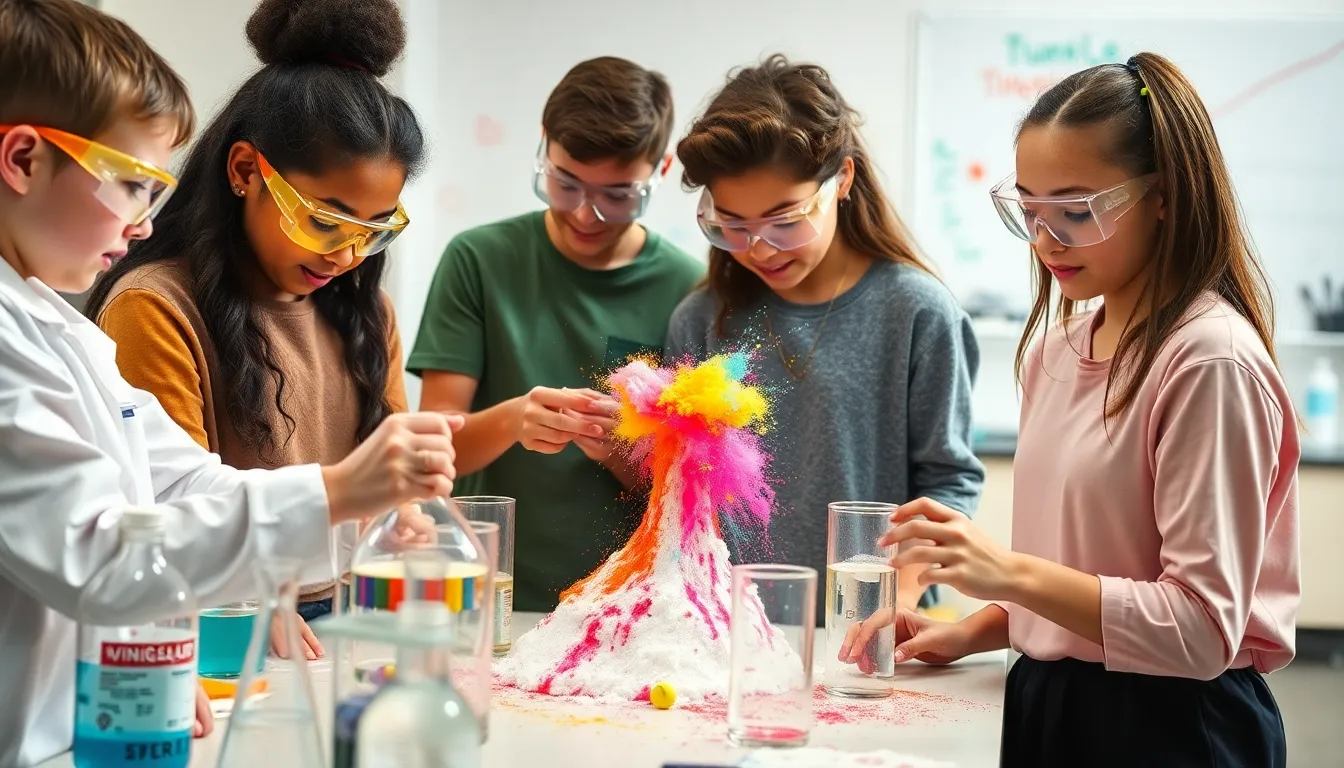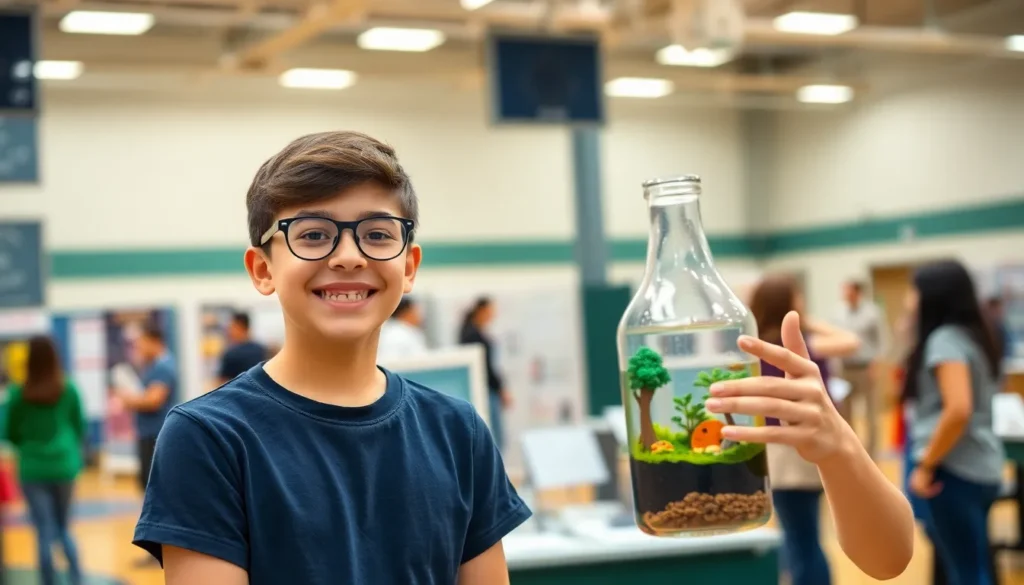Science fairs can feel like a high-stakes game of “Who’s Got the Coolest Project?” But fear not! With a sprinkle of creativity and a dash of curiosity, anyone can turn a simple idea into a show-stopping experiment. Whether you’re aiming to impress judges or just want to avoid the dreaded “my dog ate my homework” excuse, the right science fair project can make all the difference.
Table of Contents
TogglePopular Science Fair Ideas
Engaging in popular science fair ideas allows for a broad exploration of topics. Many projects spark interest in both students and judges alike.
Environmental Science Projects
Conducting experiments on local water sources offers a hands-on approach to understanding pollution. Students can measure pH levels or investigate the impact of runoff on aquatic life. Investigating renewable energy sources, such as solar or wind, demonstrates practical applications of science. Building a simple solar oven showcases how sunlight converts into heat energy. Exploring plant growth through hydroponics can reveal fascinating relationships between variables in the environment. Each project provides insight into critical environmental issues that affect communities worldwide.
Physics Experiments
Physics experiments often captivate attention due to their dynamic nature. Demonstrating the principles of inertia with a simple balloon rocket effectively illustrates fundamental concepts. Students can explore sound waves by constructing musical instruments, revealing the science behind sound production. Another interesting idea involves investigating the effect of mass on acceleration using varied weights and a ramp. Building a catapult to launch projectiles demonstrates potential and kinetic energy in action. Each experiment challenges participants to understand the laws that govern physical interactions in the universe.
Unique Science Fair Ideas

Exploring unique science fair ideas can inspire creativity and spark interest in scientific inquiry. The following sections highlight engaging topics in biology and chemistry.
Creative Biology Topics
Investigating plant growth can lead to fascinating discoveries. Designing an experiment that compares the effects of different fertilizers on plant height showcases practical applications of biotechnology. Studying local wildlife habitats allows students to observe ecological interactions. By conducting surveys and presenting findings, participants demonstrate their understanding of biodiversity. Exploring genetic traits in plants through simple DNA extraction showcases the fundamentals of genetics. Creating a model ecosystem in a bottle provides insights into self-sustaining systems and environmental balance. Each project fosters curiosity while educating about essential biological concepts.
Fun Chemistry Experiments
Conducting kitchen chemistry experiments offers exciting opportunities for exploration. Combining vinegar and baking soda creates a spectacular volcanic eruption, illustrating chemical reactions. Investigating the pH levels of common household items reveals how acid and base interactions work. Making slime involves mixing glue and borax, showcasing polymer chemistry in a fun manner. Floating eggs in saltwater demonstrates density principles through hands-on experience. Exploring color-changing indicators using cabbage juice allows participants to learn about acid-base chemistry creatively. Engaging in these experiments highlights the captivating nature of chemistry while reinforcing essential scientific principles.
Tips for Selecting the Best Science Fair Idea
Finding the right science fair idea hinges on a few key factors. Focus on topics that ignite passion and curiosity.
Consider Your Interests
Experiment selection becomes easier with personal interests in mind. Identifying areas of genuine curiosity enhances motivation. Students might explore subjects like environmental science, physics, or biology. Passionate engagement leads to better project outcomes. Examples include researching local water quality or testing the effects of different fertilizers on plant growth. Projects that resonate often produce the most innovative results.
Assess Available Resources
Resource availability plays a crucial role in project feasibility. Evaluating accessible materials and equipment matters greatly. Schools often provide basic lab supplies, while some projects may require specific items. Participants could assess whether they have access to tools like test tubes, measurement devices, or even a garden for plant experiments. Utilizing everyday household items can simplify many projects as well. For instance, a vinegar and baking soda eruption doesn’t need specialized tools. Knowledge of available resources shapes the scope and scale of the project.
How to Successfully Execute Your Science Fair Project
Executing a science fair project involves careful planning and effective presentation. Adhering to these guidelines ensures an impactful experience.
Planning and Preparation
Identify the project idea that resonates with personal interests. Create a detailed timeline outlining each stage of the project, from research to execution. Gather necessary materials and ensure their availability. Conduct background research to support claims and discoveries. Document the process thoroughly, noting observations and results. Involve peers for feedback during the planning phase. Use a scientific method to structure the experiment logically, ensuring validity in results. Test the project multiple times to refine and guarantee accuracy.
Presentation Tips
Engage the audience with a clear and engaging presentation. Create a visually appealing display board to showcase findings effectively. Utilize charts and images to enhance understanding. Rehearse the presentation to build confidence and fluency in delivering information. Prepare for questions from judges by anticipating their inquiries. Speak clearly and at a steady pace to ensure comprehension. Dress appropriately to convey seriousness and professionalism. Keep the presentation focused on key findings while summarizing the overall experience.
Choosing the right science fair project can ignite a passion for discovery and innovation. By tapping into personal interests and available resources students can create engaging experiments that stand out. The journey from concept to execution is as important as the final presentation.
With careful planning and creativity participants can transform simple ideas into impressive projects that captivate judges and audiences alike. Embracing curiosity and the scientific method not only enhances learning but also builds confidence in budding scientists. The world of science fairs is filled with opportunities to explore and inspire.






